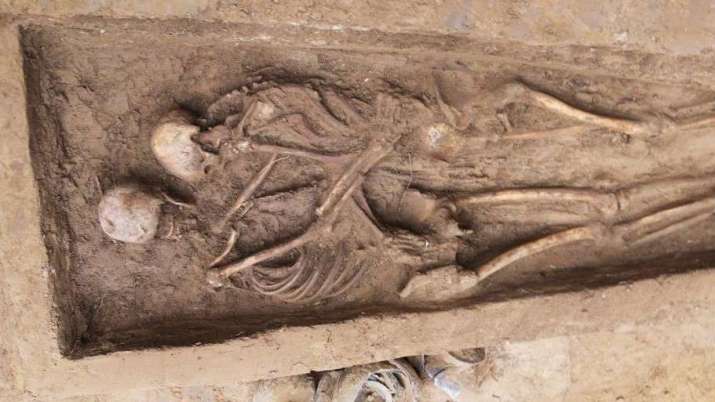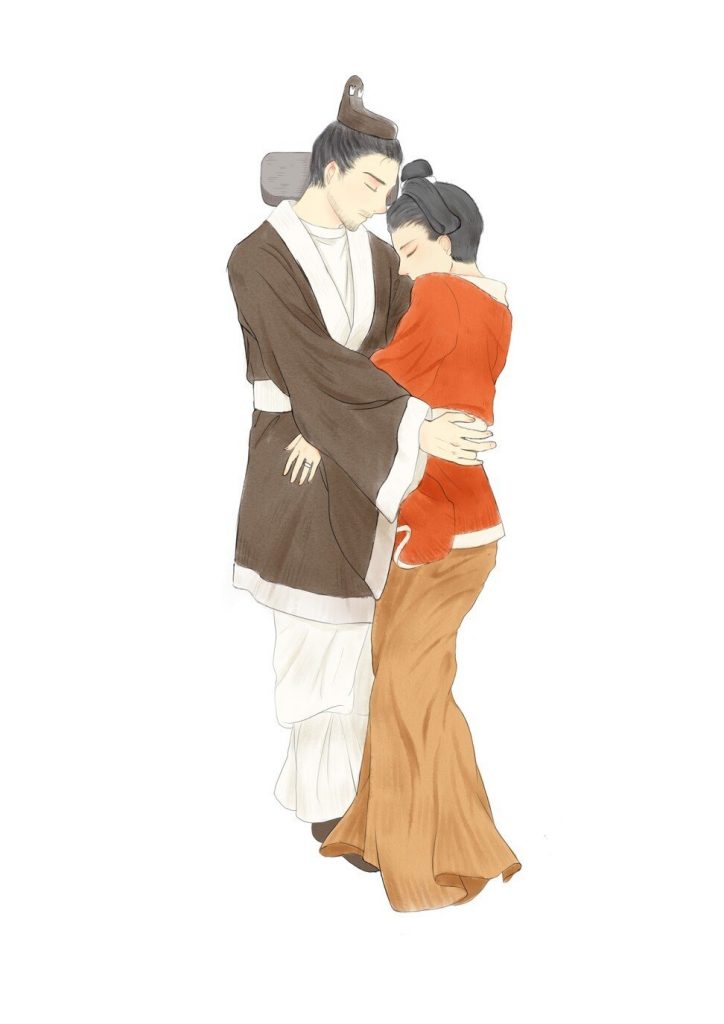NEWS
Millennia-long Love? Excavated Northern Wei Skeleton Couple Fascinates Researchers
 The embracing skeleton couple, unearthed in Datong in 2020. From chinadaily.com.cn
The embracing skeleton couple, unearthed in Datong in 2020. From chinadaily.com.cnArchaeologists in China have discovered a pair of skeletons that could have important historical significance for the study of the Buddhist Northern Wei dynasty (386–534 CE). The remains were unearthed in 2020, along with several other tombs at a construction site in Datong, Shanxi Province. The identities of the deceased couple remain unknown, although the circumstances in which their remains were found have fascinated the authors of a paper on the findings that was published in June. (Zhang et al)
Hong Kong’s South China Morning Post newspaper reports: “The position of the two skeletons suggested a deep bond. The two were found lying on their side, with the woman appearing to nuzzle her nose into the man’s shoulder. Their arms were wrapped around one another, holding the other’s waist.” (The South China Morning Post)
The two skeletons also show evidence of injuries that may correspond to self-inflicted blows, and there is even a tantalizing band on the female skeleton’s ring finger. Material goods found with them suggest that this was a commoners’ grave, and the unique possibility that it was a “lover’s burial” would make it the first of its kind in China, and reminiscent of other ancient couples seemingly interred in embrace, from the “lovers of Valdaro” in Italy to the “embracing skeletons of Alepotrypa.”
The Northern Wei was a unique Chinese dynasty as it was founded by a Xianbei royal bloodline that saw a flourishing of Buddhist diffusion and the propagation of a new style of Buddhist art. Its territory incorporated much of central and northern China, allowing it to exercise cultural influence and military leverage despite the fractured political situation at the time (the Northern Wei was bordered by the Southern Qi, the Tuyuhun, and early, pre-Yarlung Tibetan tribes). It was a politically turbulent period, with cultural and ethnic diversity shaping new ideas about death and the afterlife.
The researchers have noted that such tombs help scholars to “interpret the social perceptions of human life and death and attitudes towards love in that dynasty when the coexistence of multiple ethnic groups fueled the rise and spread of pluralistic ethos.” (China Daily)
“This discovery is a unique display of the human emotion of love in a burial,” said Qun Zhang, associate professor at the Institute of Anthropology at Xiamen University and one of the authors of the paper. “This discovery is a unique display of the human emotion of love in a burial, offering a rare glimpse of concepts of love, life, death and the afterlife in northern China during a time of intense cultural and ethnic exchange.” (The South China Morning Post)
It is even possible that the woman and man may have believed in the possibility of reuniting in the afterlife, whether in a heavenly realm or in a rebirth in the mortal world.

Illustration of the ancient Chinese couple buried
embracing during the Northern Wei.
From smithsonianmag.com
The Smithsonian Magazine noted that there are signs of physical trauma on the skeletons.* There is not enough evidence to reach a firm conclusion as to how the couple met their ends, or if they died apart or separately. However, the paper’s authors speculate that the man died first and the woman might have killed herself to be buried with her lover, or perhaps they died during a conflict or due to illness.
It is important to note that even with the woman’s ring, the exact nature of the deceased pair’s relationship is uncertain, and they might not necessarily have been in any romantic or conjugal association. However, the mysteries surrounding this couple only makes their unknown story all the more intriguing.
* Injuries on the skeletons have been revealed to be: “unhealed ulnar fracture and missing part of the fourth digit on the right hand of the male individual, a slight development of the marginal osteophytes on the lumbar vertebrae in the female skeleton, osteophytosis on the distal end of the lower limbs of the male individual, and antemortem tooth loss in the female individual.” (Smithsonian Magazine)
References
Zhang, Quanchao, Xiaogang Hou, Shiyu Yang, Sunzifeng Ruan, Anqi Wang, Pengzhen Li, Xiaofan Sun, Hong Zhu, Qun Zhang, and Qian Wang. “Eternal love locked in an embrace and sealed with a ring: A Xianbei couple's joint burial in North Wei era, China (386–534 CE).” In International Journal of Osteoarchaeology 10.1002. Published 4 June 2021.
See more
Chinese archaeologists discover ‘embracing lovers’, but it is the ring that intrigues (The South China Morning Post)
1,500-Year-Old Skeletons Found Locked in Embrace in Chinese Cemetery (Smithsonian Magazine)
Over 1,600-yr-old tomb of embracing lovers unearthed in North China (China Daily)
Best Friends Forever: Archaeologists Have Exhumed Two Hugging Skeletons at an Ancient Burial Site in China (ArtNet)
Related news reports from Buddhistdoor Global
Hong Kong Author Challenges the History of Antique Chinese Buddhist Statues
Researchers Uncover Hidden History in China’s Ancient Dunhuang Caves
Mysterious Giant Buddha Statue Discovered in Chongqing, China
Chinese and Japanese Scholars Celebrate Reproduction of Song Dynasty Tripitaka
Conservationists Turn to Digital Solutions to Preserve and Share the Treasures of Dunhuang’s Mogao Grottoes
Archaeologists in China Unearth Sutra Translation by Tang Dynasty Monk Xuanzang
Related features from Buddhistdoor Global
The Reopening of the Kanjing Royal Cave Temple at China’s Longmen Grottoes
Rediscovering the Women of Northern Wei with Stephanie Balkwill














